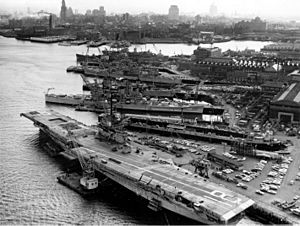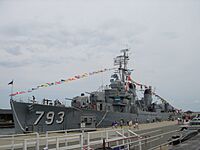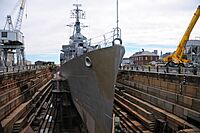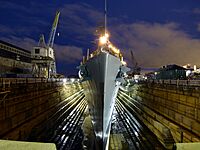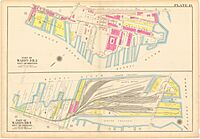Boston Navy Yard facts for kids
Quick facts for kids |
|
|
Boston Naval Shipyard
|
|
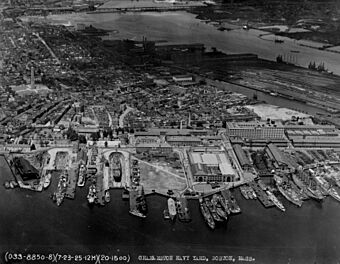
Navy Yard in the 1930s
|
|
| Location | Southeast of Chelsea Street, Charlestown, Boston, Massachusetts |
|---|---|
| Built | 1800 |
| Architect | Alexander Parris, et al. |
| NRHP reference No. | 66000134 |
| Added to NRHP | 15 November 1966 |
| Boston Naval Shipyard | |
|---|---|
| Boston, Massachusetts | |
| Type | Shipyard |
| Site information | |
| Controlled by | United States Navy |
| Site history | |
| Built | 1800 |
| In use | 1801–1975 |
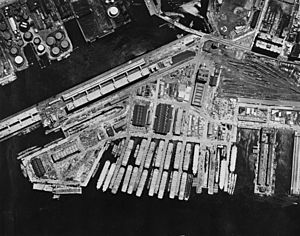
The Boston Navy Yard, also known as the Charlestown Navy Yard, was a very old place where ships were built and repaired for the United States Navy. It started in 1801. After serving the country for 175 years, it closed down as a military base on July 1, 1974.
Today, the 30-acre area is managed by the National Park Service. It is now part of the Boston National Historical Park. Some parts of the yard are still used to support the USS Constitution. This famous ship, nicknamed "Old Ironsides," was built in 1797. It is the oldest warship still active in the United States Navy and floating in the world.
Another ship, the USS Cassin Young (DD-793), is also docked here. It's a Fletcher-class destroyer from World War II (1943). This ship is now a museum ship that visitors can explore. The museum area also has a dock. You can even get there by using the MBTA Boat water transport system. Many local people and the National Park Service still call it the Charlestown Navy Yard.
The South Boston Naval Annex was a part of the Navy Yard. It was located along the South Boston Waterfront from 1920 to 1974. During World War II, other smaller annexes helped the Navy Yard. These included the Chelsea Naval Annex, East Boston Naval Annex, and the Boston Naval Yard Fuel Depot Annex.
Contents
Naval shipbuilding in Charlestown, Massachusetts, began during the American Revolutionary War (1775–1783). This area is across the Charles River and Boston Harbor from the city of Boston. The land for the Charlestown Navy Yard was bought by the U.S. government in 1800. The yard officially opened shortly after.
The yard built the first U.S. ship of the line, USS Independence, in 1814. It also built at least twelve small ships for the American Civil War. However, it was mostly used for repairs and storage until the 1890s. That's when it started building modern steel ships for the "New Navy." By then, it was known as the Boston Navy Yard.
First Dry Dock and Ropewalk
On June 24, 1833, an important event happened. The early U.S. frigate Constitution was the first ship to use the new naval drydock in New England. A dry dock is a special basin that can be drained of water. This allows workers to repair the bottom of a ship. Many important people, including Vice President Martin Van Buren, watched this event. The dry dock was designed by a famous engineer named Loammi Baldwin Jr..
The Charlestown Ropewalk made ropes for the Navy. It opened in 1837 and continued making ropes until the Yard closed in 1975. After the American Civil War (1861–1865), the Yard focused more on equipment and training new sailors.
Modernization and World War II Efforts
In the late 1880s and 1890s, the Navy began to grow again. New, modern warships made of steel and powered by steam brought new life to the Yard. In the early 1900s, a second dry dock was added.
During World War II (1939–1945), the Boston Navy Yard was very busy. It helped repair British Royal Navy warships and merchant ships. These ships were often damaged by German attacks while crossing the North Atlantic Ocean. On September 27, 1941, the Boston Navy Yard launched two destroyers, USS Cowie and USS Knight.
Even before the U.S. officially joined World War II, the Boston Navy Yard was chosen for an important task. In November 1941, it was one of four U.S. naval shipyards that built Captain-class frigates for the Royal Navy. This was part of the Lend-Lease program, which provided military aid to allies. When these ships were finished, some were used by the United States Navy as destroyer escorts.
After the Wars
After World War II, the shipyard updated many ships for the Cold War (1945–1991). This program was called Fleet Rehabilitation and Modernization (FRAM). The Korean War (1950–1953) and Vietnam War (1964–1975) did not bring much work to the yard. This was because it was so far from the fighting. The Yard finally closed after the Vietnam War. It was also home to the Marine Barracks Boston.
Dry Docks and Shipways
The Boston Navy Yard had several important dry docks and shipways for building and repairing ships.
| Dock Number | Built From | Length | Completed |
|---|---|---|---|
| 1 | Granite | 348 feet (106 m) | 1833 |
| 2 | Granite and concrete | 719 feet (219 m) | 1905 |
| 5 | Concrete and steel | 518 feet (158 m) | 1942 |
| South Boston Annex | |||
| 3 | Granite and concrete | 1,158 feet (353 m) | 1919 |
| 4 | Reinforced concrete | 687 feet (209 m) | 1943 |
| January 1, 1946 | ||
|---|---|---|
| Shipbuilding Ways | Width | Length |
| 1 | 100 feet (30 m) | 445 feet (136 m) |
| 2 | 110 feet (34 m) | 425 feet (130 m) |
Ships Built Here
What's There Now
When the Navy Yard closed, people had many ideas for what to do with the space. One popular idea was to turn it into a place to build oil tankers. However, those plans didn't happen. Instead, the site became part of the Boston National Historical Park. Its main goal is to teach people about the history of naval shipbuilding.
The Boston Navy Yard has many interesting attractions. These include the Charlestown Naval Shipyard Park. The famous USS Constitution and the museum ship USS Cassin Young (DD-793) are docked at Pier 1. Visitors can go aboard and explore them. The Navy Yard is also home to the USS Constitution Museum.
Dry Dock No. 1 is still used today. It helps with maintenance for the Constitution and Cassin Young. For example, in May 2015, the Constitution entered the dry dock for three years of important repairs.
The Yard is located near the northern end of the Freedom Trail. The MBTA Boat stops at nearby Pier 4, making it easy for visitors to get there. The campus of the MGH Institute of Health Professions uses seven buildings in the Yard for classrooms, offices, and clinics. Spaulding Rehabilitation Hospital and several Massachusetts General Hospital research labs are also located around the area.
Gallery
See also


